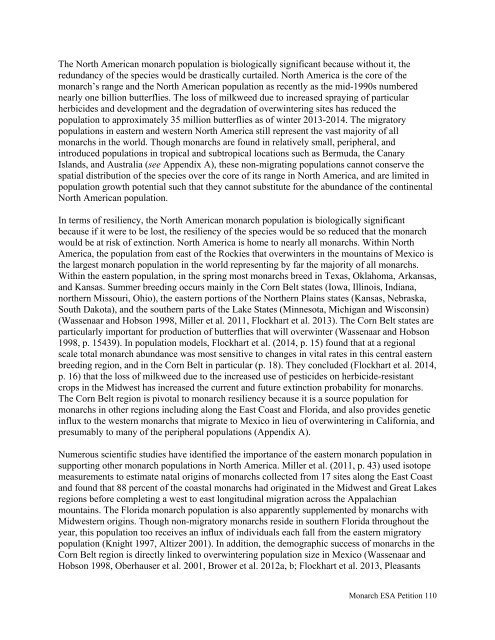monarch-esa-petition-final_61585
monarch-esa-petition-final_61585
monarch-esa-petition-final_61585
Create successful ePaper yourself
Turn your PDF publications into a flip-book with our unique Google optimized e-Paper software.
The North American <strong>monarch</strong> population is biologically significant because without it, the<br />
redundancy of the species would be drastically curtailed. North America is the core of the<br />
<strong>monarch</strong>’s range and the North American population as recently as the mid-1990s numbered<br />
nearly one billion butterflies. The loss of milkweed due to increased spraying of particular<br />
herbicides and development and the degradation of overwintering sites has reduced the<br />
population to approximately 35 million butterflies as of winter 2013-2014. The migratory<br />
populations in eastern and western North America still represent the vast majority of all<br />
<strong>monarch</strong>s in the world. Though <strong>monarch</strong>s are found in relatively small, peripheral, and<br />
introduced populations in tropical and subtropical locations such as Bermuda, the Canary<br />
Islands, and Australia (see Appendix A), these non-migrating populations cannot conserve the<br />
spatial distribution of the species over the core of its range in North America, and are limited in<br />
population growth potential such that they cannot substitute for the abundance of the continental<br />
North American population.<br />
In terms of resiliency, the North American <strong>monarch</strong> population is biologically significant<br />
because if it were to be lost, the resiliency of the species would be so reduced that the <strong>monarch</strong><br />
would be at risk of extinction. North America is home to nearly all <strong>monarch</strong>s. Within North<br />
America, the population from east of the Rockies that overwinters in the mountains of Mexico is<br />
the largest <strong>monarch</strong> population in the world representing by far the majority of all <strong>monarch</strong>s.<br />
Within the eastern population, in the spring most <strong>monarch</strong>s breed in Texas, Oklahoma, Arkansas,<br />
and Kansas. Summer breeding occurs mainly in the Corn Belt states (Iowa, Illinois, Indiana,<br />
northern Missouri, Ohio), the eastern portions of the Northern Plains states (Kansas, Nebraska,<br />
South Dakota), and the southern parts of the Lake States (Minnesota, Michigan and Wisconsin)<br />
(Wassenaar and Hobson 1998, Miller et al. 2011, Flockhart et al. 2013). The Corn Belt states are<br />
particularly important for production of butterflies that will overwinter (Wassenaar and Hobson<br />
1998, p. 15439). In population models, Flockhart et al. (2014, p. 15) found that at a regional<br />
scale total <strong>monarch</strong> abundance was most sensitive to changes in vital rates in this central eastern<br />
breeding region, and in the Corn Belt in particular (p. 18). They concluded (Flockhart et al. 2014,<br />
p. 16) that the loss of milkweed due to the increased use of pesticides on herbicide-resistant<br />
crops in the Midwest has increased the current and future extinction probability for <strong>monarch</strong>s.<br />
The Corn Belt region is pivotal to <strong>monarch</strong> resiliency because it is a source population for<br />
<strong>monarch</strong>s in other regions including along the East Coast and Florida, and also provides genetic<br />
influx to the western <strong>monarch</strong>s that migrate to Mexico in lieu of overwintering in California, and<br />
presumably to many of the peripheral populations (Appendix A).<br />
Numerous scientific studies have identified the importance of the eastern <strong>monarch</strong> population in<br />
supporting other <strong>monarch</strong> populations in North America. Miller et al. (2011, p. 43) used isotope<br />
measurements to estimate natal origins of <strong>monarch</strong>s collected from 17 sites along the East Coast<br />
and found that 88 percent of the coastal <strong>monarch</strong>s had originated in the Midwest and Great Lakes<br />
regions before completing a west to east longitudinal migration across the Appalachian<br />
mountains. The Florida <strong>monarch</strong> population is also apparently supplemented by <strong>monarch</strong>s with<br />
Midwestern origins. Though non-migratory <strong>monarch</strong>s reside in southern Florida throughout the<br />
year, this population too receives an influx of individuals each fall from the eastern migratory<br />
population (Knight 1997, Altizer 2001). In addition, the demographic success of <strong>monarch</strong>s in the<br />
Corn Belt region is directly linked to overwintering population size in Mexico (Wassenaar and<br />
Hobson 1998, Oberhauser et al. 2001, Brower et al. 2012a, b; Flockhart et al. 2013, Pleasants<br />
Monarch ESA Petition 110




